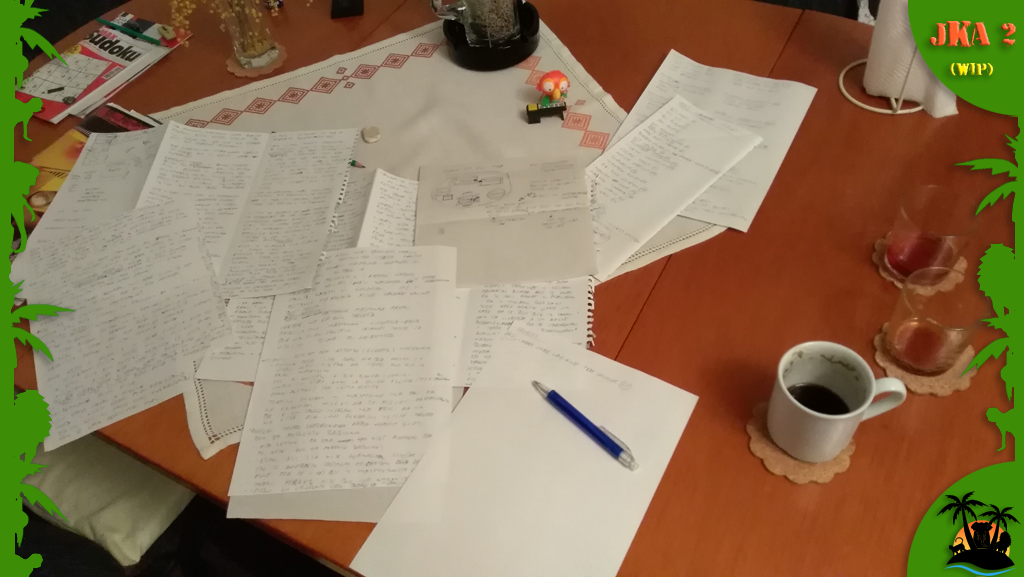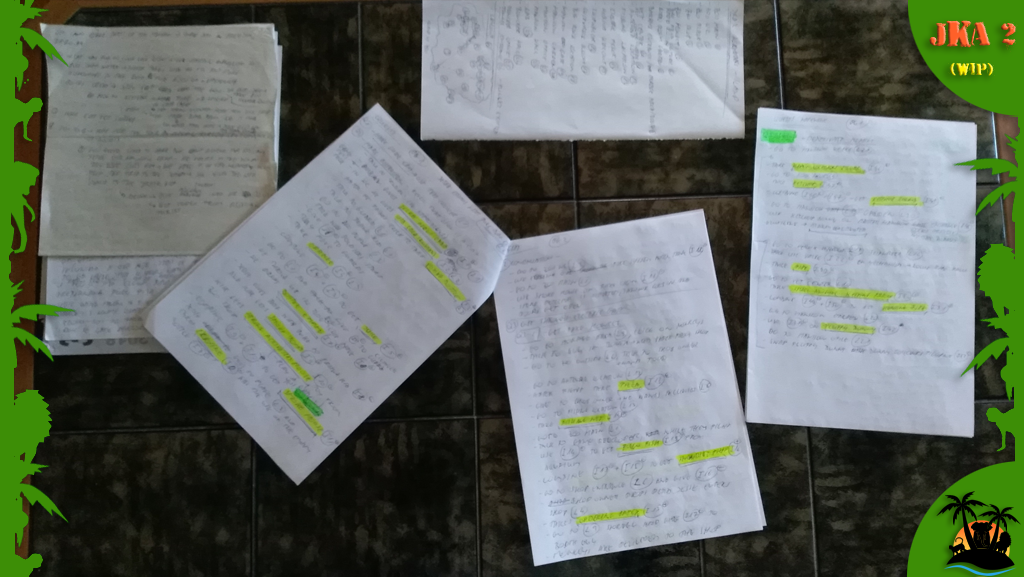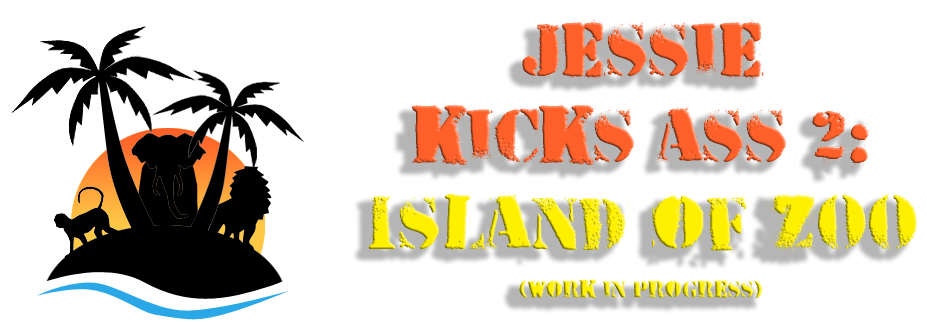Starting the game design...
Starting the game design...
Hello!
I'll talk a little about game design and how do I start one. There are set of rules you need to be aware of and I'll try to explain those using JKA2 as an example.
Firstly I would like to recommend a book about game design – "Level Up! The Guide to Great Video Game Design" by Scott Rogers.
This is an excellent book and it covers game design in great detail, but also is very easy to read, easy to understand and fun!
I learned a great deal from this book and I recommend it wholeheartedly.
Now let's go back to game design from my experience...
Design is often explained as a product of "brainstorming" process and "thinking out of the box" process and although these concepts are great as notions, when they are used by untrained mind they become path to destruction.
With that in mind let's check out the limitations those two processes usually try to avoid.
Limitations...
There always are production limitations designer should be aware of – if not by his own knowledge or experience, then via production/management team guidance.
Basic limitations game production always has are:
- Technical limitations – limitation of the game engine and skill limitation of the people using that engine.
- Time limitation – how much time can be allocated to the project?
- Finances – that one is self explanatory, and you can't have former two without this one.
In short – if the design needs too much production time or too many fancy features and is ignoring those production limitations – project is already screwed.
This sounds so logical and simple, but in reality it is something almost always overlooked and even disregarded at the project beginning.
Now that designer knows what can and what can't be part of the game, designer can limit the design additionally! Yeah... it's terrible I know...
Let's see what "brainstorming" and "thinking out of the box" actually is... in my experience?
Instead of enriching the design by new ideas and approaches, it often represents designer's own personal desires which are interesting only to that designer as a person. And this can go so far and wide it eventually ends up being bunch of nonsense impossible to implement and/or uninteresting to play to anyone else.
So one of the basic limitations for design, in my opinion, is:
- Empathy – or determining who target audience is and what target audience wants. Is it a commercial product and what niche it fits in? Or is it independent project with no expectations so you can design whatever you want?
I intentionally didn't call this "target audience" because (from my experience) designer needs to be empathic and needs to really understand what customers want. If you say "our target audience wants..." you can just copy-paste ideas from other games and, in my book, that doesn't make you a designer.
This can be branched further, and again I recommend "Level Up!" book for designing details.
Some of the examples I will mention while explaining JKA2 game design.
Starting the game design for JKA2...
When I decided to make JKA2 I already had experience while making JKA1 game, which in reality was a test for any further project made in similar environment.
That helped me a lot in determining how I can fit my ideas within limitations I mentioned.
I will explain pros and cons but my basic tradeoff is simple – my main goal is to FINISH the game and any con small enough not to destroy my main goal is acceptable.
Limitations...
Again those... damn...
- Technical limitations – since I've made JKA1 using RPGMV all the features I wanted were already tested and working. So that shouldn't be a problem.
- Time limitations – I'll do it in my free time. No problem here... if I don't starve before it's finished.
- Finances – what finances? It's my free time - no problem!
No problem? We have a problem, a huge one!
Two out of three production limitations are undetermined and if this was a commercial product it would mean - STOP. But it is independent solo project and as such depends ONLY on my ability to find time to finish it... only on that...
Now finally we are going to design the game. And yes – game design IS part of game production! In my time in game industry (15 years – over 15 projects) I saw two or three Game Design Documents (GDD) that could pass as real Game Design Documents. And I'm not talking about my personal projects. So when I'm saying that making a GDD is part of the production process I'm fully aware that in most cases there is no real GDD and creating one is considered nuisance and is usually done in a day or two.
If there is anything written it's mostly just a few sentences about the game, few technical details, dialogues, and TODO tables with number of scenes, characters, items and such.
GDD for a development team should be equivalent to architectural blueprint for a building company. Any developer in the world should be able to finish the game using this GDD. TODO lists are helpers for production, not game design itself!
- Empathy – It's an independent project so I don't have target audience! Why should I care?
Well, I do care and I want to make game fun and interesting. Having that in mind I need to know who my target audience is and what it wants.
My game is an adventure with point and click mechanics. It also have limited RPG and fighting elements. So I have few problems again...
If JKA2 is a commercial project with financial support I would change them, but since it's not I'll leave them be, which doesn't mean I'm not aware of those problems. But I need to keep my main goal in mind always – I need to finish the game!
Main problems:
- Target audience for point and click games are hard core and picky. They will not want to play RPGMV game because they can't identify themselves with the graphic style. Huge problem... but I can't pay for different graphics and make everything from scratch in another engine... Solution:
- Main goal prevails – using RPGMV will cut my production costs and production time significantly and ultimately bring me to my main goal of finishing the project.
- I'll try to make funny and interesting trailers and teasers, show game what it really is and hope that will change mind of my hard core p&c audience.
- RPG and fighting elements – p&c audience won't like that... I could remove it, but I want Jessie to actually kick some ass. Solution:
- I'll make those elements "light" and add difficulty modifier into options.
- RPG and fighting elements – JRPG audience won't like that because it's too "light"... I could make it more difficult but I want for the game to be mainly an adventure and hope people will find characters and story fun enough... Solution:
- I'll add difficulty modifier into options.
- User Interface and item interaction – another problem directly associated with the RPGMV game engine; another problem that could eventually make p&c audience unhappy. Solution:
- I will try to find even better plugins and solutions to make gameplay more "fluid" and user-friendly.
Solution to main problems:
I could just make the game in Unity, make it an old school point and click game without RPG and fighting mechanics and change the art style completely.
That would remove almost all main problems and plenty of small ones, but I most likely would never finish the game since it would be costly in both money and time. With my main goal in the crosshair I can't afford this.
What give me hope are games like Space Pilgrim. This game series led me into using RPGM in the first place. Excellent game series in spite of clunky item interaction and other issues RPGM have. Series probably went under radar just because of the fact it was made in RPGM.
Game design...
Finally I can get to the story, characters, setting, quests... finally I can start "designing" the game.
When starting designing story for this game I wanted it to be trashy cliché but on the other hand to have some silly new twists and elements.
After JKA1 Jessie lives luxury but decides to help bring down dangerous mastermind. Of course, she decides to do that out of her own interest.
Evil mastermind lives on a remote island somewhere in the Pacific.
And that's our main game setting.
My approach to design is to always try to draw quests from locations and characters. Interactive characters need to have their own drives, some distinguished features and some personal goals. Characters and locations are mutually influenced and if this "interaction" is done good entire feel of the story, of the game, will be better and game world will be more believable and more involving to the player. Of course, overdoing it can be a problem and can break the immersion. But that depends on the game genre too.
Extremely bad example of flat characters with no history, no defined drives, randomly thrown locations and inability to tell a coherent story is The Force Awakens by acclaimed director, producer and writer J.J. Abrams.
His "work" destroys my point that designer needs to make some effort into those elements, but I guess if you have a huge company behind you you can create a monstrosity like he did.
But let's go back to making games... without huge financial support.
Again, this "interaction" I'm talking about seems logical but in reality is rarely implemented good. And that leads to tedious, boring quests. In p&c games those are often mechanical quests with nuts and bolts and cups and... crowbars... You get the picture.
I'm trying to avoid this as much as possible.
How to develop locations and characters?
Since I don't have time/money for a big game I'm forced to keep it all in one island, but that doesn't mean there won't be some diversity on that island.
My evil mastermind will need a cover business... although everyone knows he's an evil mastermind...
So I've put there a ZOO. And since ZOO is just a cover business, why put real animals in there? Our ZOO will have fake animals! And that gives me plenty of opportunities to add funny and unusual quests, avoiding bad tedious ones.
Also there should be some tourists visiting the ZOO. And why not have some strange ones... like game developers finally having some vacation time between the crunches?
Island itself doesn't need to be boring. So part of the island could be cut off because that part is dangerous. Why? Maybe because of dangerous cliffs and rocks... this leads us to shipwrecks. Great place to find interesting items... and some strange inhabitants hiding there.
Let's go back to evil mastermind... this guy probably has some special interests... maybe some weird (or even common!) pets. And some dangerous lieutenants!
And so on...
Without too many spoilers I've explained my mindflow for game design and how my ideas are being developed.
After saying "brainstorming" is bad this is how it looks in my case.

(Of course you need to have toy parrot with a synthesizer on the table! That's a must!)
There was a bunch of ideas, locations, characters, quests all put on papers... I always needed to be aware of how big/small this project should be. That's hard to determine in this stage of development and previous experiences helped me here.
Once this part was done I've written it all "properly", further adjusting the design, removing loopholes, implementing better ideas...
I've defined list of locations, list of interactive characters, list of quests, defined gameflow, items and interactions. It started to look like a design... finally!

After all this, writing of the real GDD started... because this was just the start of the game design!
Stay tuned!
(I would be surprised if anyone actually read all of this... but let's be honest, I'm writing this just for J.J. ... poor guy... I know people say it's not all about the money, but at least he has that!)
Jessie Kicks Ass 2: Island of ZOO
| Status | Prototype |
| Author | Hrtz |
| Genre | Adventure |
| Tags | 2D, Female Protagonist, Funny, Point & Click, RPG Maker, Singleplayer |
More posts
- Game Development State Report 13Dec 30, 2021
- Game Development State Report 12Oct 25, 2021
- Game Development State Report 11Sep 04, 2021
- Game Design Document state report 10Jul 06, 2021
- Game Design Document state report 09Apr 27, 2021
- Game Design Document state report 08Feb 27, 2021
- Game Design Document state report 07Aug 16, 2020
- Game Design Document state report 06Dec 01, 2019
- Game Design Document state report 05Oct 21, 2019
- Game Design Document state report 04Aug 22, 2019

Leave a comment
Log in with itch.io to leave a comment.